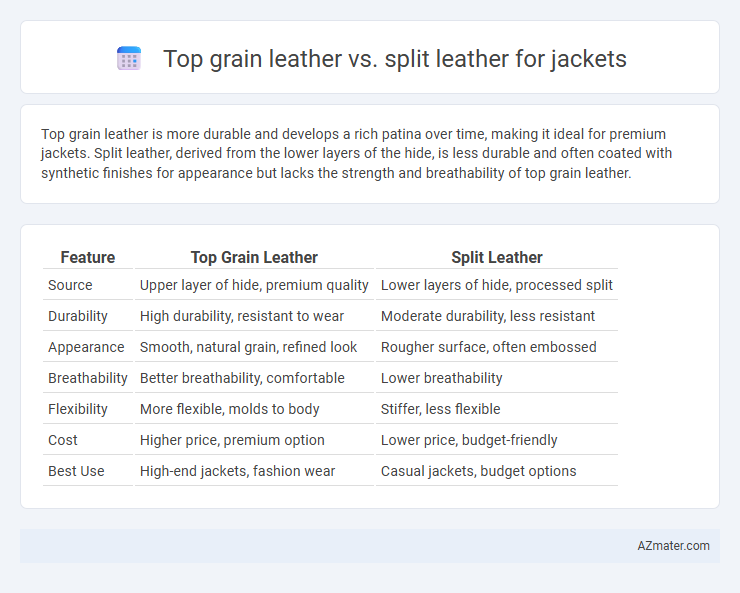Top grain leather is more durable and develops a rich patina over time, making it ideal for premium jackets. Split leather, derived from the lower layers of the hide, is less durable and often coated with synthetic finishes for appearance but lacks the strength and breathability of top grain leather.
Table of Comparison
| Feature | Top Grain Leather | Split Leather |
|---|---|---|
| Source | Upper layer of hide, premium quality | Lower layers of hide, processed split |
| Durability | High durability, resistant to wear | Moderate durability, less resistant |
| Appearance | Smooth, natural grain, refined look | Rougher surface, often embossed |
| Breathability | Better breathability, comfortable | Lower breathability |
| Flexibility | More flexible, molds to body | Stiffer, less flexible |
| Cost | Higher price, premium option | Lower price, budget-friendly |
| Best Use | High-end jackets, fashion wear | Casual jackets, budget options |
Introduction to Leather Types for Jackets
Top grain leather, derived from the outer layer of the hide, offers durability, a smooth surface, and natural grain patterns, making it a premium choice for jackets. Split leather, sourced from the lower layers of the hide, has a rougher texture and is often used for suede or coated finishes, typically offering less durability than top grain leather. Jackets made from top grain leather generally provide better resistance to wear and a more refined appearance compared to those made from split leather.
What is Top Grain Leather?
Top grain leather is the second-highest quality leather, derived from the upper layer of the animal hide after the outermost layer is sanded or buffed to remove imperfections. It retains natural grain patterns and durability, offering a smooth, sleek finish that is both breathable and resistant to stains and aging. Compared to split leather, which is made from the lower layers of the hide and lacks the grain, top grain leather provides superior strength, appearance, and longevity in jacket construction.
What is Split Leather?
Split leather is created by dividing the lower layer of a hide from the top grain, resulting in a more porous and less durable material compared to top grain leather. Used often in jackets, split leather is typically coated or embossed to improve appearance and resistance, but it lacks the natural strength and smoothness of top grain leather. Manufacturers choose split leather for its affordability and versatility despite its reduced breathability and durability.
Durability: Top Grain vs Split Leather
Top grain leather offers superior durability for jackets due to its dense fiber structure and resistance to wear, making it ideal for long-lasting use. Split leather, derived from the lower layers of the hide, is less durable and more prone to damage and stretching over time. The robust nature of top grain leather ensures better aging and resilience compared to the more fragile split leather.
Texture and Appearance Comparison
Top grain leather features a smooth, refined texture with natural grain patterns that provide a luxurious and polished appearance, making it highly desirable for premium jackets. Split leather, created from the lower layers of the hide, has a rougher and more fibrous texture, often finished with a synthetic coating to enhance its look, resulting in a less uniform and less sophisticated appearance. The natural grain of top grain leather offers greater durability and aesthetic appeal compared to the coarse and less consistent surface of split leather.
Comfort and Flexibility in Jackets
Top grain leather offers superior comfort and flexibility in jackets due to its smooth surface and natural grain retention, allowing better breathability and pliability. Split leather, derived from the lower layers of the hide, tends to be stiffer and less breathable, reducing overall comfort and ease of movement. Jackets made from top grain leather adapt more easily to the wearer's body shape, making them ideal for prolonged use and dynamic activities.
Breathability and Moisture Resistance
Top grain leather offers superior breathability due to its intact grain layer, allowing better air circulation and moisture wicking, which keeps the wearer comfortable during extended use. In contrast, split leather, derived from the lower layers of the hide, has reduced breathability and tends to retain moisture, increasing the risk of discomfort and odor buildup. Moisture resistance is significantly higher in top grain leather because its natural oils and tighter fiber structure repel water more effectively than the porous surface of split leather.
Care and Maintenance Differences
Top grain leather jackets require minimal maintenance, benefiting from their durable, natural grain surface that resists stains and moisture better than split leather. Split leather jackets demand more frequent conditioning and waterproofing due to their porous, fibrous texture, which is prone to dryness and damage if neglected. Proper care for top grain leather generally involves occasional cleaning with mild soap and applying leather conditioner, while split leather needs extra protection to maintain appearance and flexibility over time.
Cost: Which Leather Offers Better Value?
Top grain leather generally offers better value for jackets due to its durability, smooth surface, and ability to age gracefully, justifying its higher price point with long-term performance. Split leather, derived from the lower layers of the hide, is typically less expensive but lacks the robustness and refined finish of top grain leather, which can result in quicker wear and lower overall lifespan. Consumers seeking cost-effective options might consider split leather jackets for budget constraints, but top grain leather remains the superior investment for quality and longevity.
Choosing the Best Leather for Your Jacket
Top grain leather offers superior durability, a smoother texture, and better breathability compared to split leather, making it ideal for high-quality jackets. Split leather, derived from the lower layers of the hide, tends to be less durable and more prone to wear but is generally more affordable and often used in budget-friendly jackets. Choosing top grain leather ensures a longer-lasting, more comfortable jacket with an attractive finish, while split leather suits those prioritizing cost over longevity.

Infographic: Top grain leather vs Split leather for Jacket
 azmater.com
azmater.com